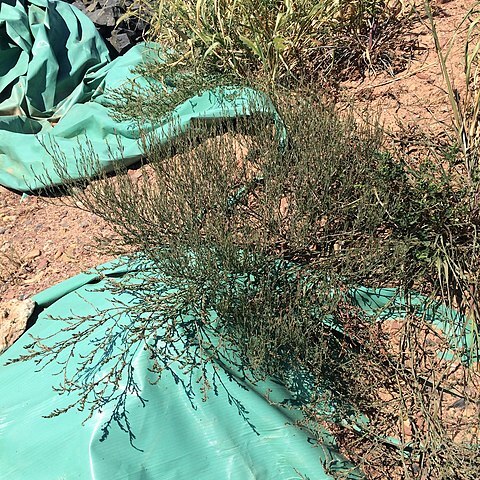Plants yellowish green or bluish green, (dark brown to black after drying in subsp. prolificum), heterophyllous or homophyllous. Stems erect, usually profusely branched in distal 2, not wiry, 10-100(-200) cm. Leaves: ocrea 6-12(-15) mm, proximal part cylindric, distal part silvery, soon disintegrating into persistent brown fibers; petiole 2-4 mm; blade variable, light yellowish green to bluish green, proximal often caducous, narrowly elliptic, lanceolate, or oblanceolate, rarely ovate, 8-70 × 4-18(-35) mm, margins flat, apex acute to acuminate or obtuse; distal leaves, either overtopping or shorter than or equaling flowers. Inflorescences axillary or axillary and terminal, spikelike; cymes uniformly distributed or crowded toward tips of branches, 2-5-flowered. Pedicels enclosed in or exserted from ocreae, 1-6 mm. Flowers closed; perianth (2-)2.2-3.6(-4) mm; tube 20-38% of perianth length; tepals overlapping, greenish yellow with greenish yellow or yellow, rarely pink or white, margins, petaloid or sepaloid, not keeled, elliptic to oblong, cucullate; midveins thickened or not; stamens 3-6(-8). Achenes enclosed in or exserted from perianth, dark brown, ovate, 3-gonous, 1.6-3.5 mm, faces subequal, concave, apex not beaked, edges straight, shiny or dull, usually smooth to roughened, sometimes uniformly or obscurely tubercled; late-season achenes common, 4-15 mm.
More
Freely branched, mostly erect or ascending annual 3–10 dm (or reputedly to 20 dm), ± strongly heterophyllous, the rameal lvs abruptly smaller than those of the main stem; lower internodes to 5 cm, the upper progressively shorter; lvs linear to narrowly lance-elliptic, 1–6 cm × 2–5(–10) mm, obtuse or acute, flat; fls 1–3 and exsert from the upper ocreae on pedicels 2–3.5 mm, forming racemes to 15 cm, mature perianth 3–4 mm, deeply cleft, the 3 outer tep cucullate and notably exceeding the inner 2, especially in fr; achenes smooth and ± shiny, the earlier ones blackish, 2–3.5 mm, thickly ovoid, and included in the perianth, but some of the later ones often paler, narrowly ovoid, 4–5 mm, and exsert; 2n=60. Unstable, usually moist, sometimes saline habitats, sometimes in coastal marshes, but also widespread inland; Me. and Que. to Wash., s. to Del., Ill., and N.M. (P. atlanticum; P. exsertum; P. triangulum)

